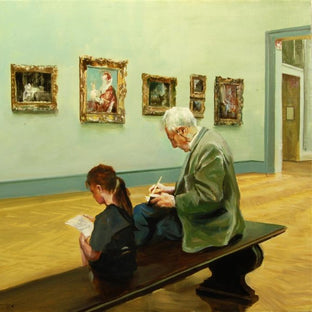The Benefits of Art Therapy for Alzheimer’s Disease



We talk to clients frequently about the meaningful ways in which art speaks to them and depending on the person, their answers are often different. One thing is constant however and that is the fact that people are drawn to art that stirs some sense of emotion, whether it be happiness, or curiosity, pleasure or even reminiscent sadness.
For many Alzheimer’s patients, though they experience declining cognition with disease progression, they still may retain the ability to experience an emotional response to art. And just as art speaks to them, they can often utilize the creation of art to express themselves. These are among some of the most compelling reasons that art has been identified to have powerful benefits for Alzheimer’s patients and others afflicted with dementia.
We know that Alzheimer’s can’t be healed, however modern science is making advances in terms of treatments. We also recognize that art has healing qualities for living with diseases, which is why Alzheimer’s disease and other forms of dementia are included in our series of articles relating to art for healing.
(Please note that the following is not intended to be a substitute for professional medical advice, diagnosis, or treatment, and does not constitute medical or other professional advice)
How Alzheimer’s Disease Affects Cognition
What most of us associate with Alzheimer’s Disease is memory loss, and Alzheimer’s is the leading cause of dementia. The disease typically afflicts people over 65 and unfortunately, its degenerative impact on the brain and cognitive function is progressive. In addition to memory loss, Alzheimer’s symptoms may include disorientation, mood changes, and over time, difficulty swallowing, walking and talking
How Art Therapy Fosters Healing
As a general rule utilizing art through creative activities can stimulate brain function with helpful results for some patients. There are many ways that art can be used for healing, both as a hands-on creative application as well as through the experience of art in a more passive way as the viewer. Whether as an application which they are engaged in directly, or as a spectator, for Alzheimer’s patients, one of the most valuable ways that art is therapeutic is in its ability to bring moments of joy.
Art is Uplifting: Feeling “Refreshed, Enriched and Alive”
New York City’s Museum of Modern Art (MoMA) is world-renowned for its exceptional collection and exhibitions of masterworks. What has us particularly in awe of its programming is its creation of “Meet me at MoMA, the MoMA Alzheimer’s Project: Making Art Accessible to People with Dementia.” The program ran for several years and was groundbreaking in its simplicity, with regularly scheduled sessions in which dementia patients and their caregivers were invited to experience the various artworks at MoMA in an engaging and lively exchange with docents.
According to MoMA staff, the discussions were always thoughtful and the participants made wonderful observations about the artworks. They note in particular that dementia patients felt a sense of respect that was validating. One participant described the experience of an evening at MoMA as feeling “refreshed, enriched and alive.” Similar programs have been duplicated in other areas of the country in order to share the healing effects of art.
Art Engages the Memory: “I Remember Better When I Paint”
Hilda Gorenstein flourished as a painter of marine ships in the 1930s and for decades thereafter, gaining recognition for her portrayal of the history of the US Navy in murals as part of a commission by the US government.
Many years later as an older adult she struggled with the challenges of Alzheimer’s Disease, for which her daughter Berna recognized her agitation and frustration. One day she asked her mother if she would like to try painting again, and her response was telling. “I remember better when I paint,” Hilda said.
Although she struggled with getting started again, with the help of some local art students which Berna hired to work with her, Hilda not only painted, she created an entirely new collection of works, including hundreds of watercolor paintings. Some reflected her usual style while others charted new territory with abstract and other thoughtful creations which demonstrated an engaged and active mind.
Art Facilitates Expression
“They may not seem to want to — or be able to — talk but can paint something that takes our breath away,” Ruth Drew, director of family and information services for the Alzheimer’s Association.
Some Alzheimer’s patients lose language altogether, so the ability to express themselves in alternate ways can take on greater meaning. While for many their verbal capacity begins to deteriorate, their creative capacity, which uses a different part of the brain, may remain intact for a time, allowing them to participate in hands-on art therapy experiences.
Another positive element of the group art sessions is that a trained facilitator can often elicit communication from those who can but are hesitant to speak. The sessions encourage a back and forth exchange between the amateur artist and the art therapist. Participants are able to share what they see and feel in response to art as a stimulus.
Art Brings People Together
One aspect of Alzheimer’s Disease that is particularly painful is the sense of loss that is felt not only by the patient, but also that is shared by their loved ones. Caring for a person with Alzheimer’s Disease is undoubtedly a labor of love. Artist Susanne Dotson was a caretaker for her mother in her final years of the disease, and during that period Susanne’s art was focused on pieces that she hoped that her mother would enjoy. While Susanne wasn’t particularly fond of pink, she painted big beautiful florals in bold shades of pink, simply for the purpose of injecting joy into her mother’s final days.
For people living with Alzheimer’s participating in a hands-on approach to art, many patients appreciate the experience of group art sessions which some caregivers provide, because it allows them to interact with others in a judgment-free environment. The goal isn’t to create masterpieces (although the value of their creations is undoubtedly immeasurable) but to facilitate moments of joy, a common theme we can all share in the experience of art.
We hope you’ve gained insight into some of the many ways that art can provide healing, including for people living with Alzheimer’s Disease. You can explore UGallery’s collections of original art, many of which are focused on peace and optimism, and check out new art weekly on our website.





